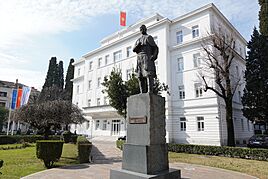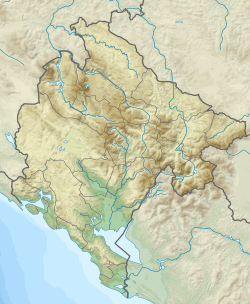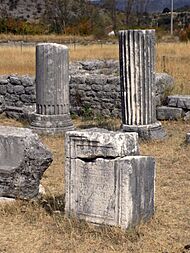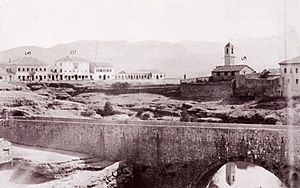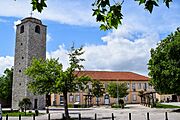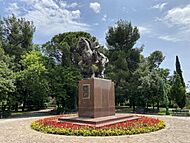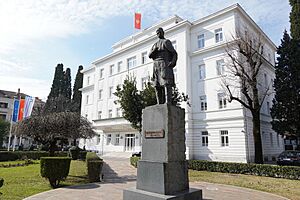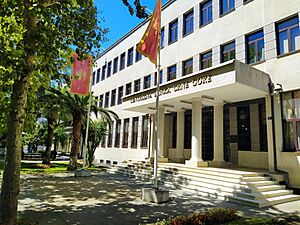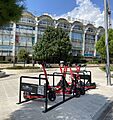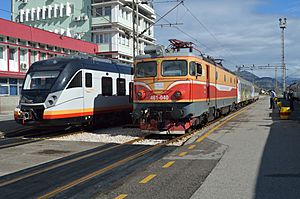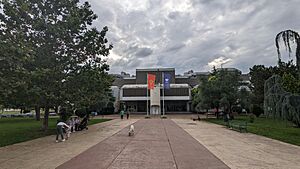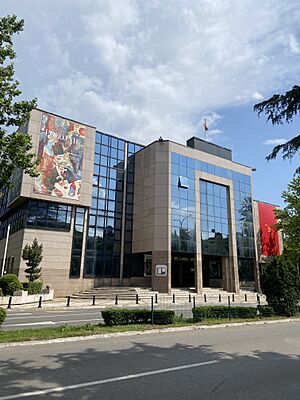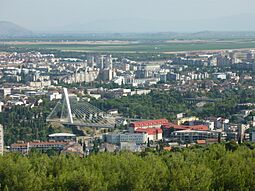Podgorica facts for kids
Quick facts for kids
Podgorica
Подгорица
|
|||
|---|---|---|---|
|
|||
|
Panoramic view of Podgorica
Millennium bridge
Clock Tower
Partisans Monument
Petrović-Njegoš dynasty Royal Estate
Business center Kruševac
Independence square
Municipal Building
|
|||
|
|||
| Country | |||
| Municipality | |||
| Founded | Before 11th century | ||
| Government | |||
| • Type | Mayor-Assembly | ||
| • Body | City Assembly of Podgorica | ||
| Area | |||
| • Capital city | 108 km2 (42 sq mi) | ||
| • Metro | 1,441 km2 (556 sq mi) | ||
| Elevation | 40 m (130 ft) | ||
| Population
(2023)
|
|||
| • Rank | 1st in Montenegro | ||
| • Urban | |||
| • Rural | |||
| • Metro | |||
| Demonym(s) | Podgorician (Podgoričanin) (male) (Podgoričanka) (female) |
||
| Time zone | UTC+01:00 (CET) | ||
| Postal code |
81 000 – 81 124
|
||
| Area code(s) | +382 20 | ||
| License plate | PG | ||
| Climate | Csa, Cfa | ||
Podgorica (Montenegrin Cyrillic: Подгорица, pronounced [pǒdɡoritsa]; meaning under the hill) is the capital and largest city of Montenegro. It's located just north of Lake Skadar and close to the Adriatic Sea. Podgorica's location where the Ribnica and Morača rivers meet, and near the fertile Zeta Plain, made it a great place for people to settle. The area around the city is mostly mountainous.
After World War II, Podgorica became the capital of Montenegro in 1946. It was renamed Titograd to honor Josip Broz Tito, who was the leader of Yugoslavia. Podgorica served as the capital until Montenegro became independent in 2006. The city's original name, Podgorica, was given back in 1992 after Yugoslavia broke apart.
Podgorica's economy includes manufacturing, trade, and services. The city has a growing technology sector with many new companies. It's also a main hub for Montenegro's transportation, with roads, railways, and the Podgorica Airport. Tourism is also becoming more important, as the city is a starting point for exploring Montenegro's natural beauty and cultural sites.
The University of Montenegro, the country's biggest school, is in Podgorica. The city also has important cultural places like the Montenegrin National Theatre and the Natural History Museum. About one-third of the city is made up of parks, gardens, and natural areas, including the nearby Gorica Hill.
Some famous landmarks in Podgorica are the Millennium Bridge, the Clock Tower, and the Cathedral of the Resurrection of Christ. You can also find historical sites like the ancient Roman town of Doclea and the old Ottoman area called Stara Varoš.
Contents
- Understanding the Name of Podgorica
- A Look at Podgorica's Past
- How Podgorica is Governed
- Podgorica's Location and Nature
- People of Podgorica
- Podgorica's Economy
- Getting Around Podgorica
- Learning in Podgorica
- Culture and Arts in Podgorica
- Sports in Podgorica
- Podgorica's City Look
- Famous People from Podgorica
- Podgorica's International Connections
- See also
Understanding the Name of Podgorica
Podgorica is written as Подгорица in Cyrillic. Its name literally means "under the hill." The word Gorica (Cyrillic: Горица) means "little hill" and refers to a small, cypress-covered hill that overlooks the city center.
About three kilometers northwest of Podgorica are the ruins of an ancient Roman town called Doclea. The Roman Emperor Diocletian's mother came from this town. In the Middle Ages, the town was known as Ribnica (Cyrillic: Рибница). The name Podgorica started being used in 1326.
From 1946 to 1992, the city was called Titograd (Cyrillic: Титоград). This name honored Josip Broz Tito, who was the President of Socialist Federal Republic of Yugoslavia. In 1992, the city's name was changed back to "Podgorica," which it is still called today.
A Look at Podgorica's Past
Early Settlements and Roman Times
Podgorica is located where many important historical routes meet. It's near several rivers like the Zeta, Morača, and Ribnica, in a fertile lowland close to Lake Skadar and the Adriatic Sea. The earliest signs of human life here date back to the late Stone Age.
During the Iron Age, two Illyrian tribes, the Labeates and the Docleatae, lived in this area. The Roman town of Doclea was home to about 8,000–10,000 people. Its location, good climate, and strong defenses made it a very important place.
The name Podgorica was first written down in 1326. The city was important for trade, with routes connecting the Republic of Ragusa and Serbia passing through it. This helped Podgorica grow into a busy center for trade and communication.
Under Ottoman Rule
The Ottoman Empire took control of Podgorica in 1474. They built a large fortress in 1479, making Podgorica a key military base in the region. The Ottomans also settled 5,000 Muslim families in Podgorica to strengthen their control.
The city's look changed a lot under Ottoman rule. They built towers, gates, and walls, making Podgorica appear like a military city.
Between 1760 and 1831, most of Montenegro, including Podgorica, was ruled by the Albanian Bushati Family from Shkodra. They ruled somewhat independently from the Ottoman Sultan.
In 1878, the Congress of Berlin recognized Podgorica as part of the new Principality of Montenegro. At this time, Podgorica had about 1,500 houses and over 8,000 people from different faiths living together.
Monarchies and World Wars
After 1878, Podgorica became part of Montenegro, ending four centuries of Ottoman rule. The city began to develop, with new roads and tobacco becoming an important product. In 1904, the first major financial institution, Zetska savings bank, was formed.
World War I stopped Podgorica's growth. The city was bombed several times by Austria-Hungary and occupied from 1916 to 1918.
After the war, Montenegro merged with the Kingdom of Serbia to form the Kingdom of Serbs, Croats, and Slovenes. Podgorica had about 14,000 people during this time.
[[File:Aerial photo of bombing of Podgorica.JPG|thumb|right|Bombing of Podgorica in World War II] During World War II, Podgorica was bombed over 80 times. The city was first bombed by the Luftwaffe in April 1941. In May 1944, the USAAF bombed the city, killing about 400 civilians. Podgorica was freed on December 19, 1944.
Socialist Yugoslavia Era
After World War II, Podgorica was largely destroyed. Josip Broz Tito visited the city in 1946 and promised to rebuild it.
On July 25, 1948, Podgorica was renamed "Titograd" in honor of Tito. This name change was made official for records starting from July 13, 1946, when it became the capital of Montenegro within Yugoslavia.
New factories were built in Titograd, like the Radoje Dakić factory for heavy machinery. The Kombinat aluminum plant was also built in 1969. In 1974, the Veljko Vlahović University was founded. In 1979, the city was damaged by a strong earthquake.
By the late 1980s, Titograd was known as one of the greenest cities in Yugoslavia.
Modern History
As Yugoslavia began to break apart, Titograd was renamed Podgorica again on April 2, 1992.
The Yugoslav wars mostly avoided Podgorica, but the country faced economic problems and high inflation due to international sanctions. In 1999, Podgorica was hit by airstrikes during the NATO bombing of Yugoslavia.
On July 13, 2005, the new Millennium Bridge opened. After Montenegro became independent in May 2006, Podgorica developed significantly as the capital. The former Ivan Milutinović Square was rebuilt and renamed Independence Square.
In October 2015, protests took place in Podgorica regarding Montenegro joining NATO.
How Podgorica is Governed
The city government includes a mayor, a city assembly, and various departments. The city assembly has 61 members, who are elected for four-year terms. The mayor is now chosen by the city assembly and needs their support to stay in office.
Since April 13, 2023, Olivera Injac from the PES party has been the mayor. She is the first mayor not from the DPS since 1998.
Podgorica's Location and Nature
Podgorica is in central Montenegro, about 15 kilometers north of Lake Skadar. The Morača and Ribnica rivers flow through the city. Other rivers like the Zeta and Cijevna are nearby. The Morača is the largest river in the city.
Unlike most of Montenegro, Podgorica is mostly flat, at an elevation of 40 meters. The city is surrounded by hills. The most important is Gorica Hill (130.3 meters high), which gave the city its name. Other hills include Malo brdo ("little hill"), Velje brdo ("big hill"), Ljubović, and Dajbapska gora.
The city area itself covers 108 square kilometers.
Podgorica's Climate
[[File:Podgorica, piazza repubblica.JPG|thumb|right|180px|Independence Square.]] Podgorica has a climate that is a mix of humid subtropical climate and hot-summer Mediterranean climate. Summers are hot, with temperatures around 34°C, and winters are mild, around 11°C. Even though the city is only about 35 kilometers from the Adriatic Sea, Mount Rumija blocks much of the sea's influence.
Podgorica gets a lot of rain, with an average of 1659 mm per year, making it the wettest capital in Europe. Temperatures go above 25°C for about 135 days each year. It rains about 120 days a year.
The most snowfall ever recorded was 58 cm on February 11, 2012. The highest temperature ever was 44.8°C on August 24, 2007, and the lowest was -9.7°C on February 4, 1956.
| Climate data for Podgorica (1991–2020, extremes 1947–present) | |||||||||||||
|---|---|---|---|---|---|---|---|---|---|---|---|---|---|
| Month | Jan | Feb | Mar | Apr | May | Jun | Jul | Aug | Sep | Oct | Nov | Dec | Year |
| Record high °C (°F) | 21.0 (69.8) |
27.1 (80.8) |
27.4 (81.3) |
33.8 (92.8) |
35.4 (95.7) |
40.5 (104.9) |
43.3 (109.9) |
44.8 (112.6) |
39.6 (103.3) |
33.6 (92.5) |
27.2 (81.0) |
20.8 (69.4) |
44.8 (112.6) |
| Mean daily maximum °C (°F) | 11.0 (51.8) |
12.6 (54.7) |
16.3 (61.3) |
20.7 (69.3) |
25.8 (78.4) |
30.7 (87.3) |
33.9 (93.0) |
34.5 (94.1) |
28.4 (83.1) |
22.8 (73.0) |
16.5 (61.7) |
11.8 (53.2) |
22.1 (71.7) |
| Mean daily minimum °C (°F) | 2.2 (36.0) |
3.4 (38.1) |
6.4 (43.5) |
9.9 (49.8) |
14.5 (58.1) |
18.9 (66.0) |
21.6 (70.9) |
21.8 (71.2) |
17.0 (62.6) |
12.3 (54.1) |
7.4 (45.3) |
3.5 (38.3) |
11.6 (52.8) |
| Record low °C (°F) | −9.6 (14.7) |
−9.7 (14.5) |
−5.6 (21.9) |
−0.2 (31.6) |
1.2 (34.2) |
8.0 (46.4) |
12.2 (54.0) |
8.8 (47.8) |
6.0 (42.8) |
0.0 (32.0) |
−5.4 (22.3) |
−8.0 (17.6) |
−9.7 (14.5) |
| Average precipitation mm (inches) | 165 (6.5) |
164 (6.5) |
164 (6.5) |
136 (5.4) |
98 (3.9) |
60 (2.4) |
36 (1.4) |
54 (2.1) |
147 (5.8) |
176 (6.9) |
261 (10.3) |
232 (9.1) |
1,693 (66.8) |
| Average precipitation days (≥ 0.1 mm) | 12 | 12 | 12 | 13 | 10 | 9 | 5 | 6 | 7 | 9 | 14 | 13 | 122 |
| Average relative humidity (%) | 72 | 68 | 65 | 65 | 63 | 60 | 52 | 52 | 62 | 68 | 75 | 74 | 65 |
| Mean monthly sunshine hours | 122.7 | 126.0 | 170.0 | 193.5 | 250.8 | 276.3 | 339.7 | 314.1 | 251.5 | 201.4 | 126.4 | 108.8 | 2,481.2 |
| Source 1: National Oceanic and Atmospheric Administration | |||||||||||||
| Source 2: Hydrological and Meteorological Service of Montenegro | |||||||||||||
People of Podgorica
| Historical population | ||
|---|---|---|
| Year | Pop. | ±% |
| 1948 | 14,369 | — |
| 1953 | 19,868 | +38.3% |
| 1961 | 35,054 | +76.4% |
| 1971 | 61,727 | +76.1% |
| 1981 | 96,074 | +55.6% |
| 1991 | 117,875 | +22.7% |
| 2003 | 136,473 | +15.8% |
| 2011 | 150,977 | +10.6% |
| 2023 | 173,024 | +14.6% |
| Population size may be affected by changes in administrative divisions. | ||
Podgorica is the largest city in Montenegro. Almost a quarter of all Montenegrin citizens live here. In 2023, there were 173,024 people living in the city proper. The average age of people in Podgorica is 35.7 years.
Ethnic Groups in Podgorica
According to the 2011 census, the population of Podgorica is made up of:
- 60.25% Montenegrins
- 23.98% Serbs
- 3.99% Bosniaks or ethnic Muslims
- 4.67% other ethnic minorities
Languages Spoken
Montenegrin is spoken by 44.43% of the people and is the most common language. Serbian is the second most spoken, at 42.28%. Other languages like Albanian, Romani, Bosnian, and Croatian are also spoken.
Religions in Podgorica
Religion in Podgorica (2011) Eastern Orthodoxy (81.45%) Islam (9.91%) Irreligion (5.08%) Roman Catholicism (1.81%) Other Christians (1.64%) Other religions (1.05%)
Podgorica has three main religious groups: Orthodox Christians, Sunni Muslims, and Catholic Christians.
Most Orthodox Christians are Montenegrin and Serb people who became Orthodox in the Middle Ages. They are the largest religious group. Churches include St. George Church (from the 11th century) and the Cathedral of the Resurrection of Christ, which is the city's largest church.
The Muslim population is mainly made up of Bosniaks and Albanians. There are several mosques in Podgorica.
The Catholic population is mostly the local Albanian minority. Their main church is the Church of the Holy Heart of Jesus, built in 1966 in a unique Brutalist style.
Podgorica's Economy
Podgorica is the most important economic center in Montenegro. Most of the country's industries, banks, and businesses are located here.
Before World War I, Podgorica's economy was based on trade and small manufacturing. After World War II, it became the capital and grew quickly with new industries like aluminum, tobacco, textiles, and wine production.
In the 1990s, the breakup of Yugoslavia and international sanctions caused many industries to close. However, some, like Plantaže (a wine producer), survived and still contribute a lot to Montenegro's economy.
As Montenegro moved towards independence, Podgorica benefited from having many government and service jobs. It is home to the Montenegro Stock Exchange, major financial institutions, telecommunications companies, media outlets, and the national airline, Air Montenegro.
The strong presence of government and service jobs helped Podgorica's economy during the late 2000s recession. Even though about 30% of Montenegro's citizens live in Podgorica, the city accounts for 44% of the country's employed people.
Getting Around Podgorica
Public Transportation
Public transport in Podgorica uses buses, with 12 city lines and 16 suburban lines. Taxi services are also very popular and offer good service with modern cars.
Roads and Highways
Podgorica is a natural hub for roads and railways because of its central location in Montenegro. Major motorway projects, like the Bar-Boljare motorway, will pass near Podgorica. The first part of the Bar-Boljare motorway opened in 2022. The Sozina tunnel (4.2 km) makes the trip from Podgorica to Bar (Montenegro's main seaport) very short.
New road bypasses have been built to move heavy traffic away from the city center. Podgorica also has many multi-lane boulevards, which make getting around the city quick. The Morača River is well-connected by 6 car bridges and 3 pedestrian bridges.
The main road connections from Podgorica are:
- North: towards Belgrade and Central Europe.
- West: towards Nikšić, Bosnia, and Western Europe.
- South: towards the Adriatic coast.
- East: towards Albania.
-
Sozina Tunnel shortens the journey from Podgorica to Montenegro's main port Bar, by some 25 km.
Rail Travel
Podgorica is a central point for Montenegro's railway system. The Belgrade–Bar line connects with lines to Nikšić and Shkodër at the Podgorica Rail Station. The station is about 1.5 km southeast of the main city square. Passenger service to Nikšić started in October 2012 after reconstruction. The line to Shkodër is only for freight.
Air Travel
Podgorica Airport is Montenegro's main international airport. It is located in Zeta Plain, about 11 km south of Podgorica city center. It is also known as Golubovci Airport. The airport's code, TGD, comes from Podgorica's old name, Titograd, when the airport first opened. It is the main base for Air Montenegro.
Learning in Podgorica
Most of Montenegro's higher education institutions are in Podgorica, including the University of Montenegro, which is the country's most important university. The university has many different faculties (departments), such as:
|
|
The university also has scientific research institutes in Podgorica, like the Institute of Foreign Languages and the Institute of Biotechnology.
The Montenegrin Academy of Sciences and Arts (CANU) is also in Podgorica.
There are also private universities, such as Mediterranean University (founded in 2006) and the University of Donja Gorica. Podgorica has 34 elementary schools and 10 secondary schools, including one gymnasium. The first secondary school, Gymnasium "Slobodan Škerović", opened in 1907. The "Radosav Ljumović National Library" is considered the best in Montenegro.
Culture and Arts in Podgorica
Podgorica is a center for Montenegrin culture. It is home to the Montenegrin National Theatre, which is the most important theater in the country. The city also has the City Theatre, which includes a Children's Theatre and a Puppet Theatre.
While not as many museums as the historic capital Cetinje, Podgorica has several interesting ones:
- The Podgorica City Museum (Muzej grada Podgorice) keeps the city's history alive. It has items from the Roman and Illyrian times.
- The Archaeological Research Centre (Centar za arheološka istraživanja) collects and displays archaeological findings.
- The Marko Miljanov Museum (Muzej Marka Miljanova) in Medun shows what life was like in 19th-century Montenegro.
- The Natural History Museum (Prirodnjački muzej) displays Montenegrin plants and animals.
There is an art gallery in the Dvorac Petrovića (Petrović Castle) complex, located in Podgorica's largest public park. This palace was turned into an art gallery in 1984 and now holds about 1,500 artworks.
The Budo Tomović Cultural-Informational Centre (KIC Budo Tomović) is an important cultural institution. It organizes many art events, including the Podgorica Cultural Summer and the FIAT – International Alternative Theatre Festival.
Sports in Podgorica
The most popular sports in Podgorica are football (soccer) and basketball. Basketball became very popular because of the success of KK Budućnost in regional and European games.
Football has a long history in Podgorica with the club Budućnost. Famous players like Predrag Mijatović and Dejan Savićević started their careers with this team. Another club, FK Zeta, from the Podgorica suburb of Golubovci, has also played in top leagues.
The volleyball team OK Budućnost and the women's handball team ŽRK Budućnost T-Mobile have also been very successful in European competitions. Budućnost Podgorica is the most important sports club in the city, and its name means Future.
Chess is also popular, and some famous chess players, like Slavko Dedić, were born in Podgorica.
Sporting events like the annual Podgorica Marathon and the Morača River jumps attract athletes from around the world. Podgorica hosted the 2009 FINA Men's Water Polo World League.
Sports Venues
Podgorica has several sports venues, some of which are being rebuilt or expanded:
- Podgorica City Stadium: This stadium can hold 11,264 people. It is the home of FK Budućnost Podgorica and the Montenegro national football team. It's the only stadium in Montenegro that meets FIFA standards for international matches.
- Morača Sports Center: This is a large indoor sports facility with 6,000 seats. It hosted some games for EuroBasket 2005.
- Bemax Arena: An indoor and outdoor sports facility with 2,400 seats.
Most football clubs in Podgorica have their own fields, even if they are small. Other notable venues include the Stadion malih sportova under Gorica hill and a sport shooting range under Ljubović hill.
Podgorica's City Look
Podgorica's buildings show its long and changing history. Different rulers brought different building styles.
Since it was part of the Ottoman Empire until 1878, some parts of Podgorica, like Stara Varoš (Old town) and Drač, have Ottoman architecture. You can see two mosques, a Turkish Clock Tower, and narrow, winding streets.
When Montenegro took over, the city center moved to the other side of the Ribnica River. This new part, called Nova Varoš (New town), has wider streets and a more European style.
During World War II, Podgorica was almost completely destroyed by bombings. After the war, new apartment blocks were built in a simple style common in communist countries. This style shaped much of the city on the right bank of the Morača River. These developments helped the city grow quickly after the war.
-
St Peter of Cetinje Boulevard
Since the late 1990s, Podgorica's architecture has changed a lot. New buildings use modern glass and steel designs. The city government is investing in public spaces to make the capital look modern and unique. New landmarks include the Hristovog Vaskrsenja Orthodox temple and the Millennium Bridge, which is a key part of Podgorica's skyline.
Famous People from Podgorica
- Stefan Nemanja (born around 1113), who founded the Nemanjić dynasty.
- Božidar Vuković (born around 1460), one of the first printers in Montenegro.
Podgorica's International Connections
Sister Cities
Podgorica is connected with these cities around the world:
Partner Cities
 Yerevan, Armenia
Yerevan, Armenia
See also
 In Spanish: Podgorica para niños
In Spanish: Podgorica para niños









